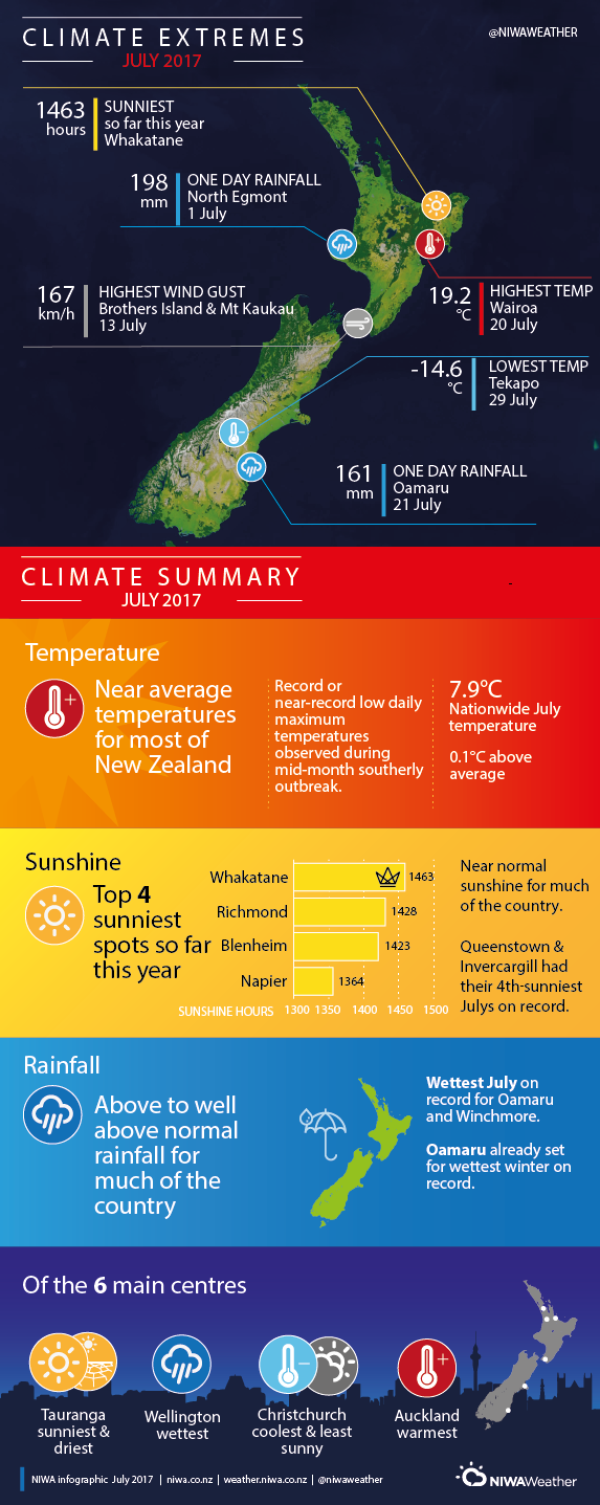A tumultuous month with record breaking rainfall for eastern South Island
|
Rainfall |
July rainfall was well above normal (>150% of the July normal) for the Greater Wellington Region, Otago and mid to south Canterbury. Rainfall was above normal (120-149% of the July normal) for large parts of the North Island and Nelson. Below normal rainfall (50-79% of the July normal) was observed in parts of Northland, the West Coast, western Southland and western Otago. |
|
Temperature |
July temperatures were near average (-0.50°C to +0.50°C of the July average) for much of the country. Temperatures were below average (-0.51°C to -1.20°C of the July average) about the districts of Hurunui, Mackenzie, Waitaki, Dunedin and Clutha as well as eastern Southland. Pockets of above average temperature (+0.51°C to +1.20°C of the July average) were observed in the Waikato and Manawatu-Whanganui. |
|
Sunshine |
July sunshine hours were near normal (90-109% of the July normal) for much of the country. The exceptions to this were parts of Wellington, Taranaki, Nelson and Christchurch where below normal (75-89% of the July normal) or well below normal (< 75% of the July normal) sunshine was observed. |
|
Soil Moisture |
As at 1 August 2017, soil moisture levels were near normal for virtually the entire country. Soil moisture was slightly higher than normal for coastal areas from Timaru to Dunedin. |
Overview
July was a tumultuous month due to the passage of several active low pressure systems and consequently there were numerous high impact weather events throughout the month. These included a major winter storm that brought snow to sea level in Otago and Tropical Cyclone Category 1 strength winds to the Wellington Region. Most notably, record breaking rainfall in parts of Canterbury and Otago led to severe flooding and the declaration of a State of Emergency. See the Highlights and Extreme Events section for full details.
In terms of temperature, there were a handful of cold spells in July which led to new record or near-record low daily maximums and minimums being set. Despite this, frequent bouts of warm weather meant that average temperatures for all of July were near average for most of the country. Sunshine hours were also near average for much of the country despite the wet flavour to the month. This can be attributed to the nature of the rain, which was often heavy but short lived.
Further highlights:
- The highest temperature was 19.2°C, observed at Wairoa on 20 July.
- The lowest temperature was -14.6°C, observed at Tekapo on 29 July.
- The highest 1-day rainfall was 197.6 mm, recorded at North Egmont on 1 July. The second highest was 161.2mm at Oamaru on 21 July.
- The highest wind gust was 167 km/hr, observed at both Brothers Island and Mt Kaukau (Wellington) on 13 July.
- Of the six main centres in July 2017, Auckland was the warmest, Christchurch was the coldest and least sunny, Tauranga was the sunniest and driest, and Wellington was the wettest.
- Of the available, regularly reporting sunshine observation sites, the sunniest four locations in 2017 so far (1 January – 31 July) are Whakatane (1463 hours), Richmond (1428 hours), Blenheim (1423 hours), and Napier (1364 hours).
Download
- July 2017 Climate Summary information [PDF 700KB]
- June 2017 Climate statistics [PDF 65KB]
Contact
For further information, please contact:
Mr Chris Brandolino, Principal Scientist – Forecasting, NIWA National Climate Centre Tel. 09 375 6335

